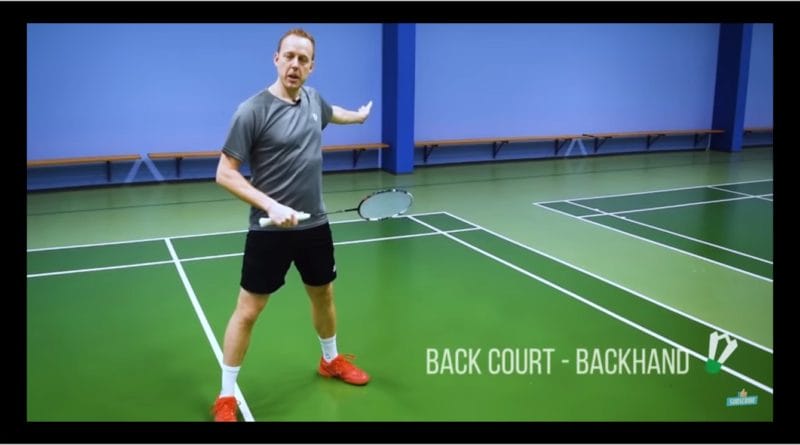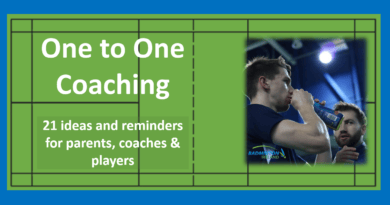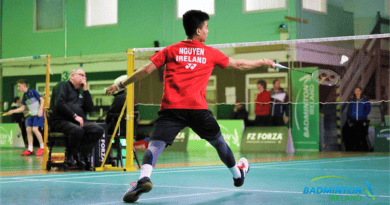Badminton Footwork Part 3 : recovery footwork in the Round the Head-court
What are your thoughts about the RECOVERY footwork in the Round the Head-court?
This post is Part 3 of a 4 part mini-series.
… Click here to read Part 1 that looks at the FH net and recovery
… Click here to read Part 2 that looks at an alternative “starting stance” for the backhand net
Have you watched the excellent footwork video by Badminton Family?
Before reading the rest of this post take a moment and watch this short extract and pay attention to the round the head recovery. Look for the movement 6:03 minutes
– – – – – – – – – – – – – – – – – –
Which round the head recovery footwork do you prefer?
-
-
-
Chasse (feet up to each other)
-
Step (walk/cross over)
-
It depends on the stroke played
-
It depends on the opponents’ return
-
– – – – – – – – – – – – – – – – – –
This round the head recovery footwork has created lots of different opinions from coaches
Should your recovery with a “Running” or “Chasse” step
Some people wanted, well almost insisted that the movement should be a chasse and not a running step
Their position was very strong, “always chasse”
Others said, use both as it depends on the stroke you have played and the reply from the opponent
Certainly, running steps are faster over longer distances, Chasse movements cover small distances efficiently.
Then there are differences in the player physical abilities and size.
So many factors, it’s tough to decide what to coach and when
Plus, when would you run straight into the net?
– – – – – – – – – – – – – – – –
My thoughts are ..
You must introduce both movements (and variations) in various practice situations and then let the player practice
It’s the practice and outcomes that will create development
Don’t just coach what it says a manual. Especially if it says only do one type 🙁
– – – – – – – – – – – – – – – –
Be prepared to challenge the player by creating situations that –
.. include decisions for player to make. Do this by using 1 shuttle and ensure it is returned over the net!
.. yes that was 1 shuttle
.. sometimes require speedy footwork: reduce the recovery time and vary the returns
.. don’t always feed from the same position. In fact, let the player start the practice by block feeding.
.. sometimes require quick changes in direction: include back to where they have just come from
.. allow for ‘kill’ and offensive opportunities but also create ‘scramble’ and defensive situations
.. exploit the opponents’ replies: can you ‘limit’ the opponent’s possible replies?
.. reward anticipation 🙂 allow for and encourage player anticipation
– – – – – – – – – – – – – – – –
Warning
Being rigid and inflexible in your teaching will only cause you issues as your players become educated in watching the game.
How will you answer their questions if they point out movements that don’t follow your advice?
Yes, YOU may be able to chasse or cover the court easily but not everyone is as powerful as you. Check if you are creating demonstration situations where you KNOW where the shuttle is going and use these to ‘prove’ your theories.
Are you deliberately (or without knowing it) setting up scenarios that you control to ‘prove’ your theories ?
– – – – – – – – – – – – – – – –
Coaches you have a decision to make
I’d like to recommend that it’s NOT about which movement you believe is best.
-
- It’s about which movement is most effective for the recovery the player needs.Therefore you need to create these situations on the court and manage the initial learning.
There is no one technique that fits all situations perfectly
Ok, I understand that it’s easy to say here when I’m not on the court with you. You are the coach and you will have to make choices.
What I can say to help you is that the more situations you expose your player to the better prepared they will be. Compromise and selection will always be required by the PLAYER you cannot teach every scenario. If things alter in the future as the players develop or grow don’t worry, embrace the change. It’s called Practice and Coaching 😉
In practice ensure that….
.. you test and stretch players and yourself (in the design of your sessions)
.. you are prepared to help when required, but please allow some desirable difficulties in the practice that ‘test’ the player
.. sometimes don’t say anything and let the challenge dictate the footwork
.. create subtle suggestions and real game images then see what happens on the court
– – – – – – – – – – – – – – – –
Can you help me?
This post has been tough to write as there are many coaches and players out there with theories on how to play and what technique to use.
I am certainly the same at times, so your feedback is essential to me. My aim is to provide guidelines that can be challenged.
I believe that it’s the PRACTICE situations that you use that will influence how you or your players develop. If you stay true to Game-like Situations and Conditions then hopefully you will develop Game-like responses.
My hope is that we create Badminton Players, not people who are great at Badminton training
– – – – – – – – – – – – – – – –
I would love to hear the results of your efforts.
If you need any further explanation please let me know. As always, I’m very grateful if you have read this far 🙂
I am certainly willing to help so send me an email. I’d love to hear your views contact@badmintonandy.com




